DISCLAIMER : Trying to delve into the metatextual madness that is the League of Extraordinary Gentlemen (henceforth refered to as the LOEG) can be a referential nightmare. Rather than subject us both to a torrent of links, I suggest that if something intrigues you, look it up. (I will still link to those things I reckon are worth it). Also, if you haven't actually read LOEG, this will be pretty spoiler-heavy. Go read the comics now, rather than wasting time on my crappy blogs! Also, destroy every copy you ever find of the LOEG movie - it does not deserve to exist.

In 1999, that Glycon-worshipping genius called Alan Moore took his encyclopedic knowledge of Victoriana and unleashed a monster. Together with his artist chum Kevin O'Neil, they created an alternate history that seamlessly melded fiction with fact, and left no corner of the contemporary pop culture unexplored. This was the LOEG. It was like a violent, kaledscopic collsion between steampunk and the classic superhero comic. Moore had always layered complicated erudtion and allusion throughout all his works, but this was really something different. Also, the excellent relationship between artist and writer gave the book the cohesiveness required to make it work.
The first volume saw the mysterious, redoubtable Mina Murray (with that scarf forever wrapped around her elegant neck) appointed leader of a dubious group of 'heroes'. These were the drug-addled has-been Quartermain, the dual-personality psychotic Jekyll/Hyde, the England-hating rebel Nemo, and the invisible rapist Griffin. They were to stand as Britain's defence against supernatural or unusual threats. They crossed paths with Fu Manchu, defeated the evil Professor Moriarty's plot to rule the skies, and introduced me to the obscure literary genre of Victorian flagellation porn.
The second volume saw them take on the Martian invasion imagined by H.G. Wells. Things very nearly ended in disaster, mainly thanks to the treachery of Griffin. He was, of course, punished with a brutal death the details of which do not concern us here. Hyde himself died in the invasion, and Nemo quit Britain in disgust after learning of the biological weapons used to stop the Martians. We were left with just Allan and Mina, now a pair world-weary lovers trying to find some meaning after all the weirdness. At the back of each book in the second volume, we also got a detailed gazetter of the greater LOEG world - a feat of metatextual genius which would have won Moore a dozen awards if it had actually been part of a so-called legimate "book".
Next came the Black Dossier. This is surely one of the biggest mindfucks in comics history. It was not really a sequel, more a massive and mutilayered reference work for the LOEG world. On the one hand it gave us the history of the LEOG from 1900 up to 1958, when the actual story is set. Most importantly we learn that Allan and Mina had travelled to Africa after the events of the second volume, and bathed in the pillar of fire described in "She", thus gaining eternal youth (and requring Allan to fake his death and return as his son). It also gave some information on the fascinating French and German equivalents to the LOEG. On the other hand it contained a wealth of false documents which added depth to the world of the LOEG and made for some great reading. These included a sequel to Fanny Hill's memoirs, a lost Shakespeare play, Wooster's run-in with Cthulhu, and the PornSec 'Jane' tijuana bible.
So it was with a lot of anticipation that LOEG fans awaited the most recent installment : Volume 3, Century - "What Keeps Mankind Alive?". This blog isn't a review, because there are plenty of well-written ones around. Suffice to say, I enjoyed it immensely. Althought the events featured in Century were already described in the Black Dossier, Moore and O'Neil create a great vignette depicting the LOEG in 1910, and how they blunder about in their attempts to save the world. It covers a series of events that occur before the main action, rather than the action itself; essentially a kind of prelude. The story is that an occultist called Oliver Haddo, essentially a Crowley analogue, seeks to bring a creature he calls the Moonchild into the world. (Did you know there are seven songs called Moonchild, including one by Debbie Gibson? Never mind, I think this is the only one which counts, especially under the circumstances). We learn in Black Dossier that Haddo was ultimately plotting to attack the coronation of King George V, and that the Moonchild thing becomes an ongoing concern. But in Century, that has all yet to happen.
It is very important to note that Century is based heavily on Brecht's Threepenny Opera. This bitter and gritty tale of life on the streets has appeared in Moore's work before, most notably Watchmen. But in Century it is a dominating theme; several characters from that play appear in the story singing their songs. Most notably we have Pirate Jenny, who in the world of the LOEG is none other than Janni, the estranged daughter of Nemo. Her famous song of revenge was immortalised by Nina Simone (you just can't find a good version of that online, but you can check out the really cool original version here). Also the murderous Macheath, better known as Mack the Knife (his song is quite well known and has been often covered, but you haven't heard it 'till you've heard Nick Cave's version). Lastly, Suki Tawdry appears to fufill her role as a kind of Greek chorus, as in the original play.
The League, as it stands in 1910, has the following members - Mina and Allan, of course, now eternally youthful. The immortal gender-bender Orlando, currently in male form, has befriended Mina and Allan and recently joined the League - or rather re-joined, as he/she had served with the numerous incarnations of the League throughout the 16th, 17th and 18th centuries. The psychic prophet Thomas Carnacki and the gentleman-burglar Raffles, round out the rest of the team.
Anyhoo, without further ado, here's my Eight Awesome Things About "Century"
1. Lulu meets Mack the Knife
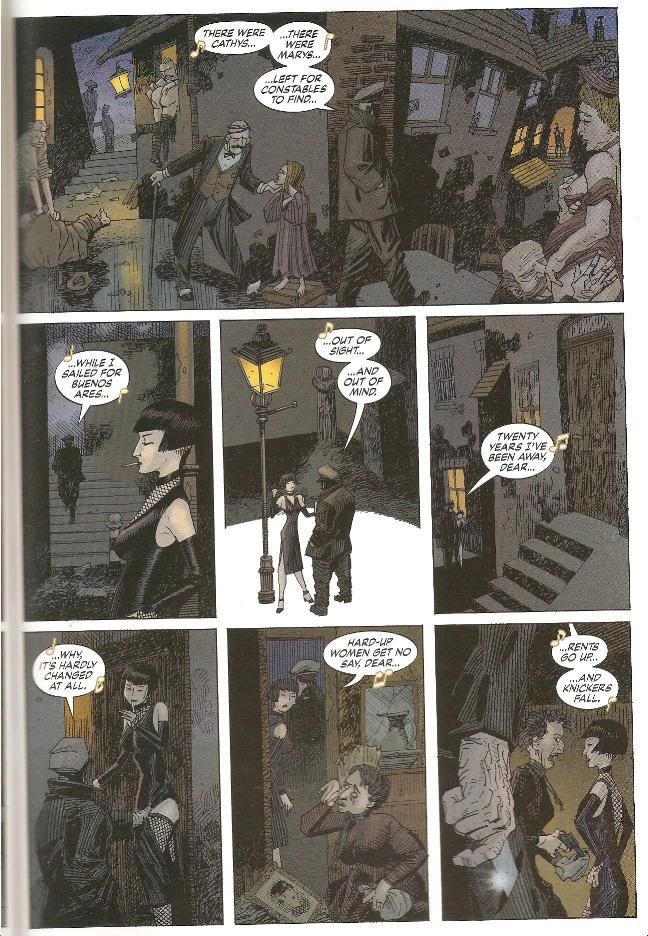
As mentioned above, the notorious Macheath - old Mac the Knife - makes a significant appearance in Century. In the world of the LOEG, we learn that he - as well as some insane algy called Lord Gurney - was responsible for the Ripper murders. He lurks the vice-ridden streets of Edwardian London - a place Moore and O'Neill know well - murdering according to his own perverse law. After the Ripper slayings he fled to Argentina, but has just recently returned to London.
And who does he happen to run into whilst stalking these streets? None other than Lulu, the beautiful siren developed by Frank Wedekind and immortalised by Louise Brooks in "Pandora's Box". (Or was it Lulu who immortalised Louise?). In that story, Lulu ends up going to London and becoming a prostitute, finally falling victim to none other than Bloody Jack 'imself. Moore adapts her tragic end slightly differently for the LOEG world; this time it is Macheath who brings her doom. Also, it's a lot more grisly.
Incidentally, the other woman is Countess Geschwitz, a maniacal lesbian obsessed with Lulu. She was stalking her in the hope of a confrontation; unfortunately for both women, Macheath has other plans.
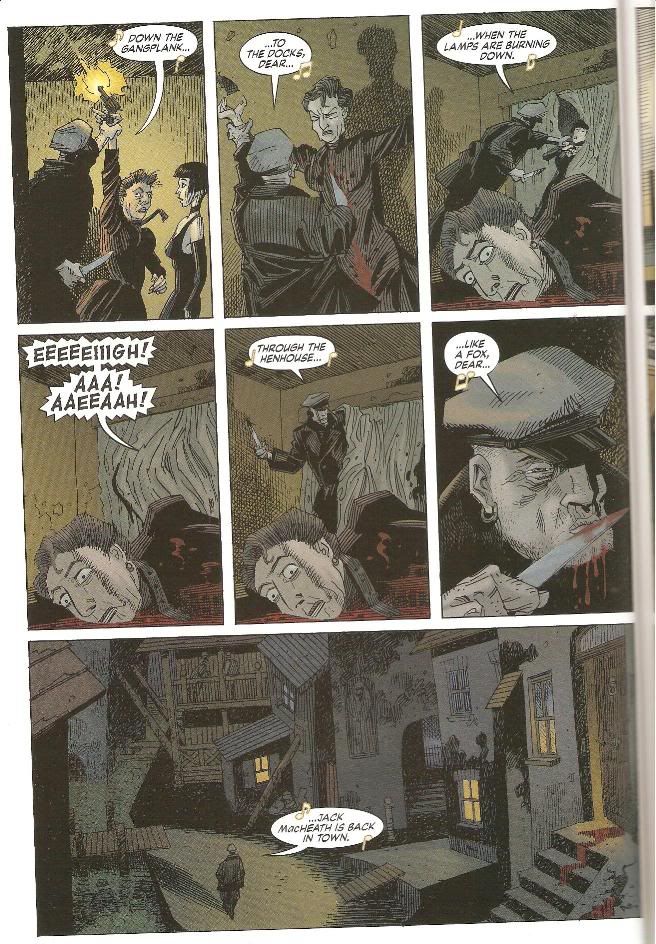
I just love the fact two of my favourite characters not only appear in Century, but collide in such a spectacular fashion. It was quite a treat, if you're an erudite ghoul.
On the back cover of Century itself, Lulu's murder is depicted in a work by the fictional artist Robin Yaldwin - a stand-in for Walter Sickert; a fellow Moore knows a lot about. Sickert was connected in some strange way to the Ripper murders, and his art is held to reflect this. Lulu and Macheath both orbit within the same pop cultural niche. Hence this false document is layered with meaning, and works incorporates several narrative threads into a singular image. It is a testament to the depth of Moore and O'Neil's work.
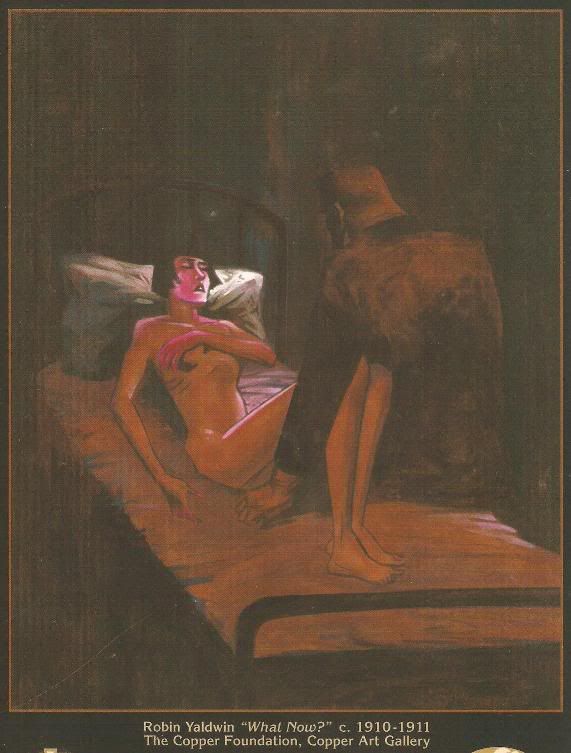
2. Totty-in-a-trunk
One of the running gags in the LOEG comics were the reproduced period Victorian/Edwardian ads. Some of these were genuine, such as the classic genital shock-collars and so forth that are well-recorded examples of historical quackery and pseudomedicine. (Famously, Moore found an authentic ad for a "Marvel douche" and wanted to run it in the comic, as a swipe at Marvel Comics, with whom Moore had had a very unhappy relationship. Moore's then-publisher, DC Comics, refused to run the ad, changing it to a Miracle-brand douche. This marked the beginning of the end of Moore's relationship with DC; he has left them since and Century was published by Top Shelf).
Other ads were deliberate fabrications, designed to mock the bizarre medical practices and social conventions of the day. Century has one of these, and it's a beauty.
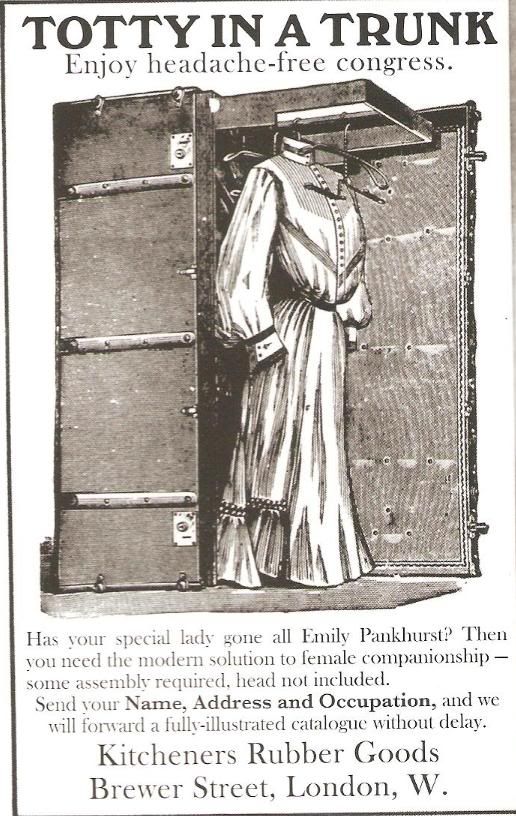
"Has your special lady gone all Emily Pankhurst?" Independent women - such as the divorced, chain-smoking Mina Murray - were the subject of much contempt and fear in the late Victorian/Edwardian world. The fact Mina leads the LOEG, and is really the only useful member in it, is a commentary on that. (Who can forget Moriaty's cutting little put-down of her : "Sergeant - throw this smelly little lesbian over the side!").
3. Andrew Norton, the Prisoner of London
British sci-fi author Iain Sinclair has written some pretty crazy books. I've only read a few, and 'Slow Chocolate Autopsy' is not one of them. But it is definitely on my must-read list now, as it's main character makes an amazing cameo in Century. Andrew Norton is a man with a bizarre gift/curse - he is trapped forever within the spatial confines of London, and can never leave the city itself. But he is free to travel through time; he moves through every period of London's history, tuning in on different times like radio frequencies. He is witness to London's thousand forgotten secrets. In Century, it is revealed that he has served as a kind of 'consultant' to Leagues throughout time, appearing every now and again to reveal arcane secrets. (In a tribute to Sinclair, O'Neill draws Norton to resemble his creator).
So, in 1910, Mina and Raffles are sent by Mycroft Holmes to meet Norton - they're told he's "due to materialise at King's Cross soon, apparently". As they head to meet him, Norton 'tunes in' on them. He sees Boudica make her last stand - in 61 AD - upon the site which will one day become the King's Cross railway station. This is actually an urban legend (and hence a reality in the LOEG!). As he gets closer he sees - what I think - is the legend of Herne the Hunter unfolding, sometime in the 13th century.

In the following two panels, the Norton scenes are quite obscure - the ordinarily awesome LOEG annotations by Jess Nevins are mute here. If I where to hazard some guesses - is that perhaps Jack Horner fleeing with his pie, while Shakespeare - at right - watches on disdainfully? And perhaps that is the construction of King's Cross in the second panel. At any rate, I love Mina's mention of Arkham - despite dispatching Dracula, Moriarty and the Martians, she is (rightly) terrifed of the Cthulhu gods.

When he arrives, Norton unleashes a torrent of cut-up madness that would make Burroughs proud. I think it's really left up to the reader to draw their own conclusions...
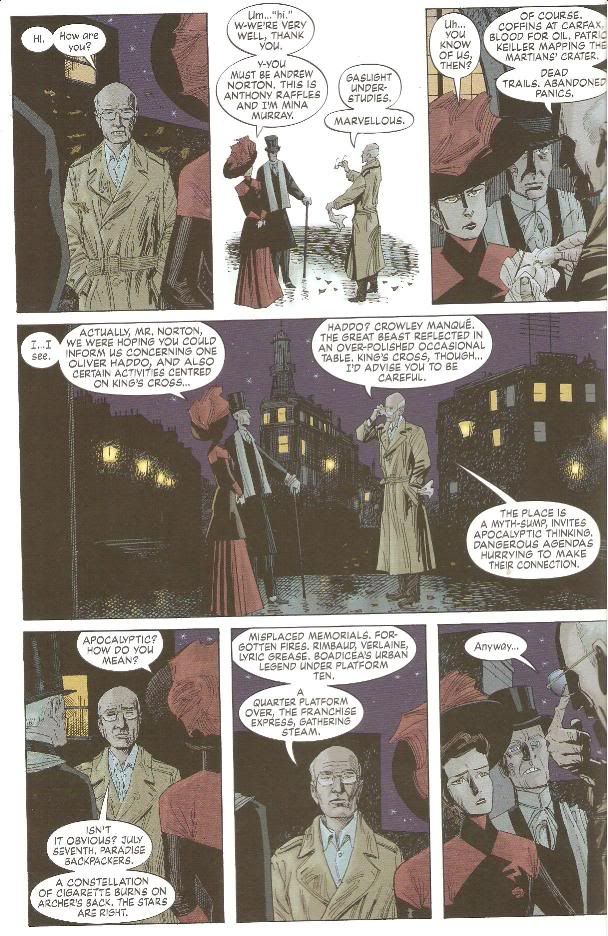
"Gaslight understudies" is a great description of the LOEG characters - Norton, having an omniscient view, puts them nicely in context (coffins at Carfax). The myth-sump thing shows Moore at his occult-London best; three threads I see drawn together in Norton's images include the 2007 King's Cross bombing, the legends about Boudica buried beneath, and a stinging swipe at Harry Potter, whose train leaves nearby ("...a quarter-platform over, the franchise express, gathering steam").
Anyway...
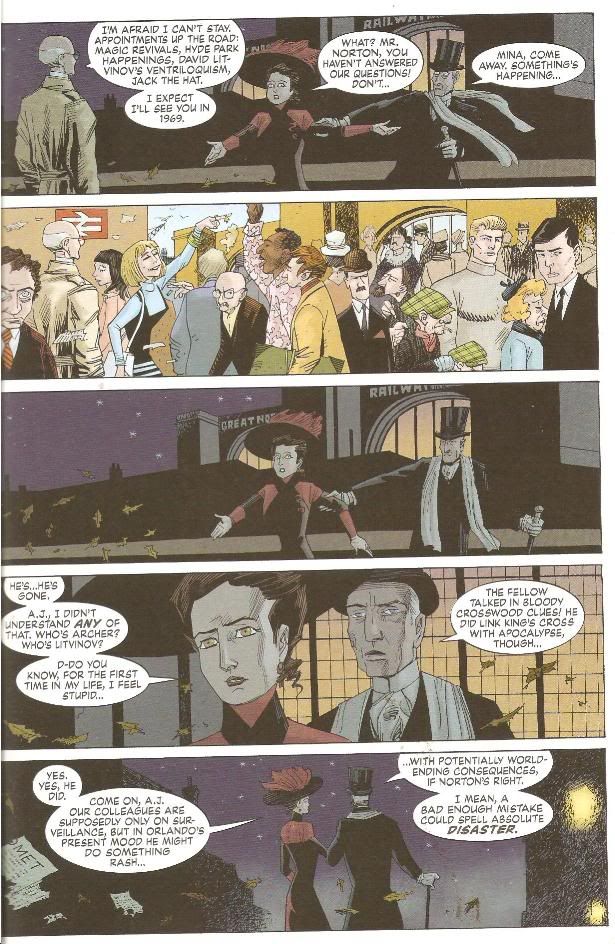
Just like that, he's gone. He was speaking directly to the (immortal) Mina when he said "see you in 1969"; that is the subject of the next LOEG volume. And check out the LOEG's swinging London! I can't place any of the characters - but I feel, maybe, that's one of Michael Caine's characters - either Charlie "Italian Job" Croker or Jack "Get Carter" Carter - on the far left, and 'Jimmy' Bond (who we met in the Black Dossier) on the far right.
4. Wow, a reference I got all by myself
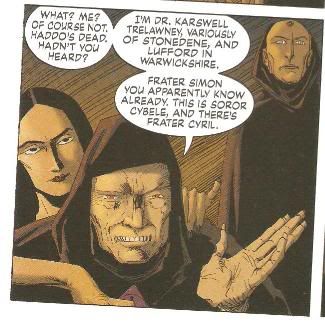
Despite what that sinister fellow says, he actually is Haddo, the Crowley-ripoff who serves as the villain in Century. But here he claims to be a certain Trelawney. This gave me a start, as I suddenly realised I had cracked an really, really obscure reference without having to research it. The name was from Anthony Powell's awesome twelve-novel series "A Dance To The Music Of Time". Trelawney is - showing layer upon layer - another Crowley analogue, who plays a small but significant role in the life of the narrator. I love the "Dance" series and realised what Moore was doing here straight away. Like the Lulu thing, it was nice to see something obscure that I liked being included in the LOEG world.
5. Pirate Jenny
As mentioned above, this character from the Threepenny Opera takes on a new form in Century. She is originally Janni, daughter of the notorious Nemo. But initially she scorns her heritage and flees to London, where she is forced to work as a maid and is badly abused by the thugs around her. Her famous song - calling for the arrival of the dreaded Black Freighter (or in some versions Raider) which will wreak havoc on all her persecutors - takes on a new tone here. The death-dealing ship is really the Nautilus, come to reclaim it's righful captain. As Suki Tawdry sings, the Nautilus' crew wreak bloody havoc on the London dockyards.
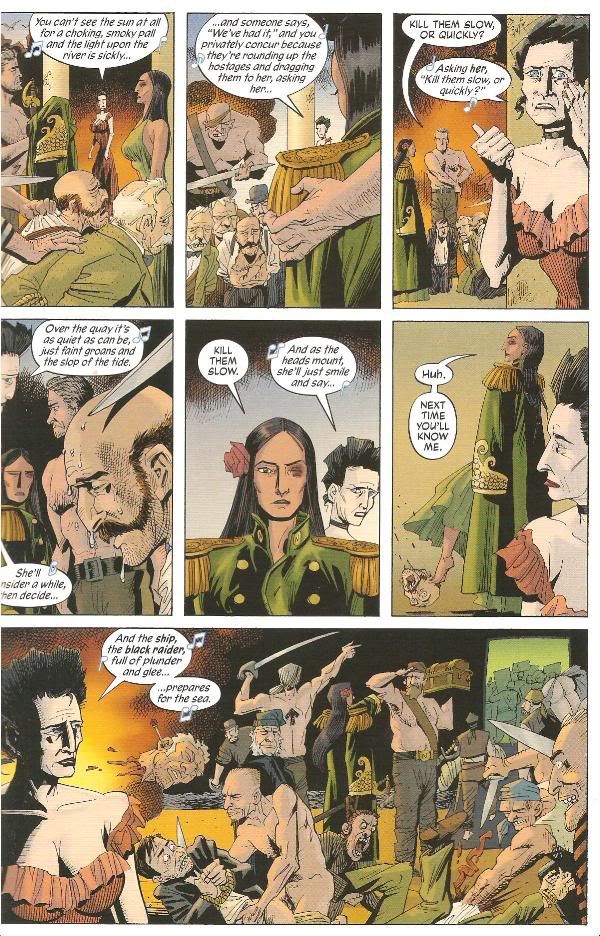
This leads onto the next awesome thing, which is...
6. Mina meets Pirate Jenny
This scene pretty much speaks for itself. Remember what "no-one" is in Latin?
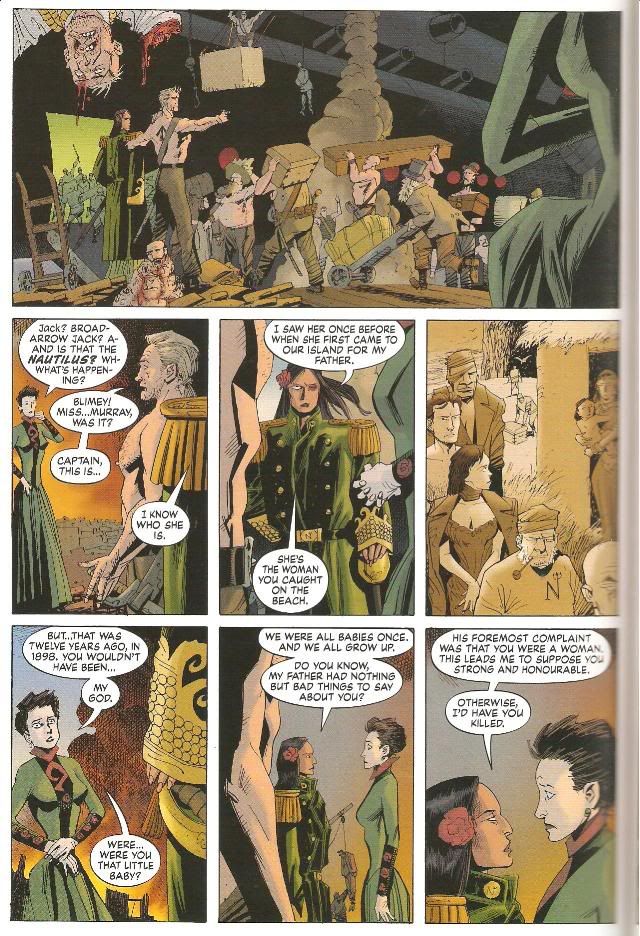
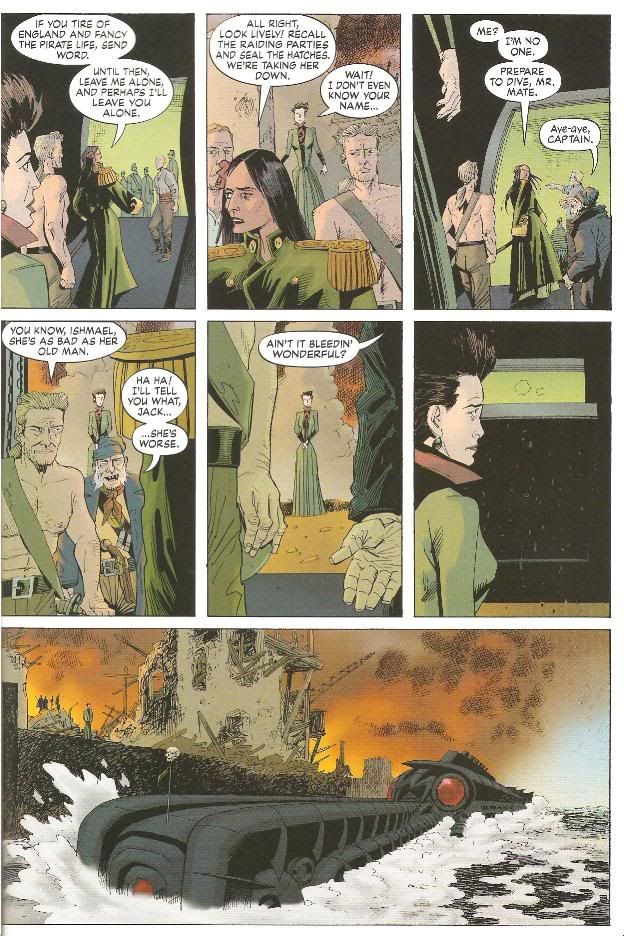
7. "O 'Lando, do shut up"
The immortal and gender-swapping character Orlando was introduced to the LOEG world in the Black Dossier. His (he's a he in Century so I'll call him he here) life story, in the form of a 40's boy's adventure comic, was a great read. In the past six millenia he's been everywhere, and done everything - and pretty much every one, as well, if you get my drift. Certainly, he never stops talking about his life.
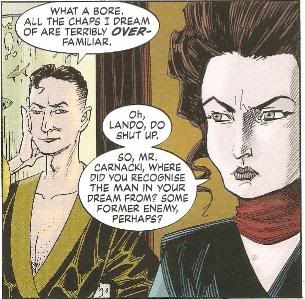
He gets some really great lines, but I have two favourite Orlando moments in Century. In this first case, the boys have just tried - and failed - to break into Haddo's hideout and interrogate him. They got badly beaten, and Orlando recieved a magic shockwave which would have killed a non-immortal. Despite this, he still manages to irritate Mina when she reprimands the boys, launching into a monologue about how "when I was with Alexander", etc. The furious Mina promptly storms off.
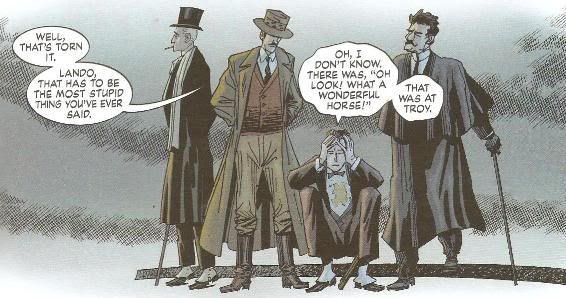
The second occassion is when the League battles the Nautlius pirates as they descend on London. Despite his prattle and egotism, Orlando has - as he often states - become very good at two things : "fighting and fucking". Wielding (what he claims) is Excalibur, he shows he's not just empty talk. Although, he still manages to irritate poor Mina.
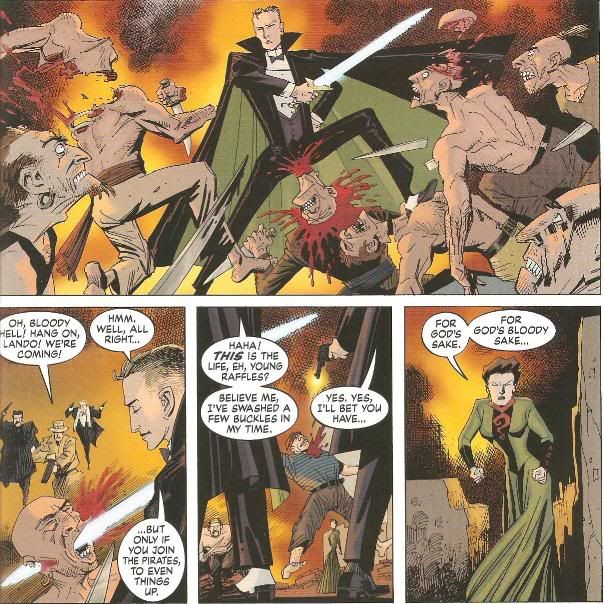
8. The Epilogue
Century ends with a dense text sequence, which supplies supplemental details to the great LOEG storyline. This was a precedent established in the second volume. The epilogue in Century details a number of things, but most interestingly for me it updated the LOEG timeline, to 1964. We learn that Allan and Orlando - the latter now a woman again - have become the characters of Rene and O, respectively, from the classic erotic novel "The Story Of O". Moore really does love his historic erotica, and ties it into the LOEG here in a cool and unexpected way.
While those two are getting kinky in Paris, Mina has far different adventures. She has teamed up with her old ally from the Black Dossier - Golliwog, the King of Toyland, with his two Dutch Wives ("Zijn geslacht is kolossaal!"). Riding about aboard his flying ship, the 'Rose of Nowhere', she is heading off to the moon for her own obscure purposes. It has been intimated that Mina is hooking up with "costume types" - the first superheroes - and this mission may have something to do with that. But as she stares into the stars, she sees a ghastly sight:

It's her old enemy Professor Moriarty, last seen at the end of volume one, "falling into space" as he clung onto his precious cavorite. Over sixty years later Mina finds him in orbit, forever frozen in a silent scream, still clutching the cause of his doom. It's a sobering moment for her, dragging her right back to when it all began. It makes a great ending.
(My regular Patrotic Nerdery blogs will return next time.)
No comments:
Post a Comment